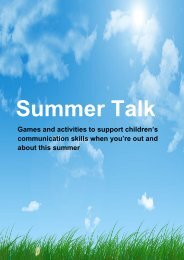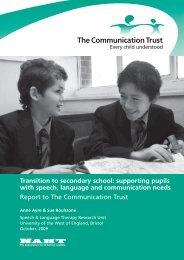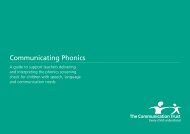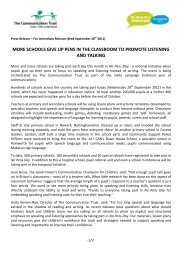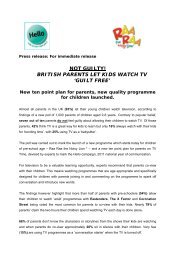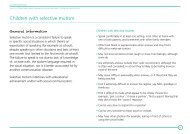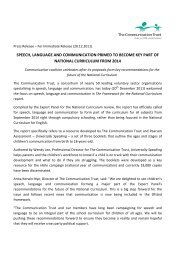Don't Get Me Wrong - The Communication Trust
Don't Get Me Wrong - The Communication Trust
Don't Get Me Wrong - The Communication Trust
Create successful ePaper yourself
Turn your PDF publications into a flip-book with our unique Google optimized e-Paper software.
Which groups of children are likely to have SLCN<br />
SLCN cuts across labels and diagnoses, so many children and young people who<br />
have other SEN labels or diagnoses also have SLCN. <strong>The</strong>re are some groups of<br />
children and young people who are at much higher risk than others, for example:<br />
• All children with SLI have SLCN which is often severe and complex – there is no<br />
obvious reason or cause for these difficulties with language, and their non verbal<br />
skills are often well developed.<br />
• All children with learning difficulties have SLCN. This affects 3% of all children 5 .<br />
• All children with autism spectrum disorders (ASD), which includes Asperger<br />
syndrome, have SLCN. <strong>The</strong>y have difficulty with social interaction and social<br />
communication. This affects 1% of all children 6 .<br />
Other children are at increased risk of SLCN, including those with:<br />
Dyslexia - a learning difficulty that primarily affects the skills involved in accurate<br />
and fluent word reading and spelling. Typical features<br />
are difficulties in: phonological awareness,<br />
verbal memory and verbal<br />
processing speed, for example<br />
ASD<br />
being able to break words<br />
down into individual sounds<br />
or parts which rhyme.<br />
Dyslexia<br />
SLI<br />
Dyspraxia (or<br />
developmental co-ordination<br />
disorder) - a difficulty with planning a<br />
sequence of co-ordinated movements<br />
which can affect speech.<br />
Dyspraxia<br />
SLCN<br />
Learning<br />
difficulties<br />
ADHD<br />
Figure 2. Groups of young people<br />
who are likely to have SLCN<br />
4 Lindsay, G., et al (2008) Effective and Efficient Use of Resources in Services for Children and Young People with Speech,<br />
Language and <strong>Communication</strong> Needs DCSF Research Report RW05<br />
5 <strong>Me</strong>ncap, www.mencap.org.uk<br />
6 Baird, G., Simonoff, E., Pickles, A., Chandler, S., Loucas, T., <strong>Me</strong>ldrum, D., Charman, T., (2006) Prevalence of disorders of<br />
the autism spectrum in a population cohort of children in South Thames: the Special Needs and Autism Project (SNAP)<br />
Lancet,15;368(9531):210-5<br />
Don’t <strong>Get</strong> <strong>Me</strong> <strong>Wrong</strong> 11




